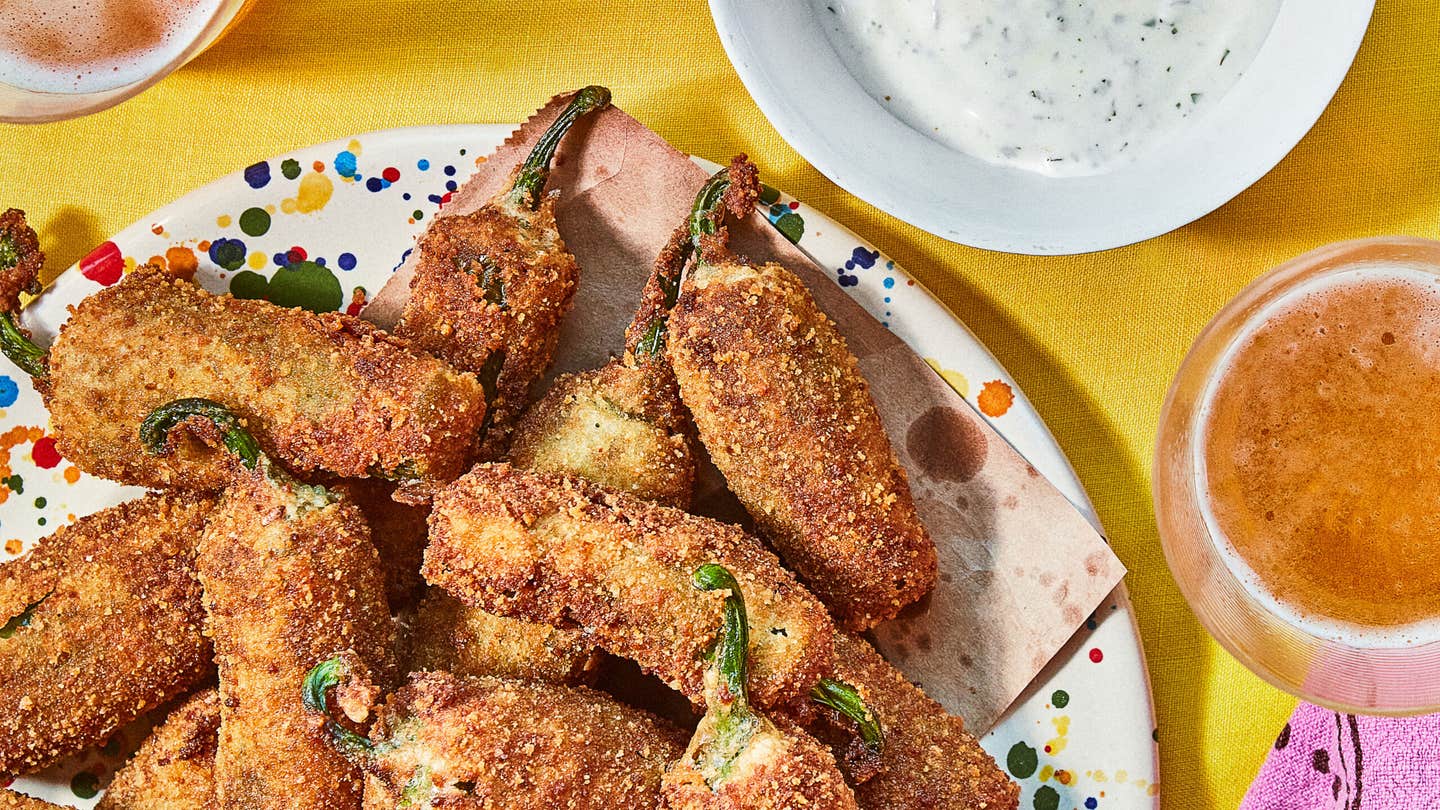Bring Back the Jalapeño Popper!
The Tex-Mex bar snack might be a U.S. invention, but the cheese-filled chile has deeper roots south of the border.

If you were to take a survey of U.S. bar menus from the 1990s, you’d notice a few appetizers that appeared again and again—a veritable canon of greasy deliciousness. There were fried onions, in both ring and “blooming” form; piles of nachos; Buffalo wings; spinach-artichoke dip. But over the course of the decade, there was one clear rising star on the list, a newcomer that went from virtually unknown to ubiquitous: the jalapeño popper.
The snack as we now know it—a whole jalapeño filled with cheese, which is then roasted or fried (or both!), sometimes wrapped in a glistening ribbon of bacon—has deep roots in Mexico, namely the dish, chile relleno, which goes back to the 1800s or earlier. Indeed, the jalapeño popper’s flavor profile is similar to its ancestral stuffed pepper: the two share a beguiling combination of creaminess and spicy heat.
Poppers are smaller, however, the better for sharing by the platterful. Snack-sized stuffed chiles began to appear in the United States in the 1950s, when import stores in Texas started advertising a canned Mexican product consisting of “jalapeños stuffed with cheese, sardines, red snapper and shrimp.” By 1960, newspapers were running stuffed chile recipes, like one in the Austin American-Statesman that included an illustration of stuffed jalapeños and detailed instructions for filling with “ground beef, chicken, turkey, ham, or grated cheese of your choice.”
This period, not coincidentally, was also when Tex-Mex cuisine began to take the form we know today and to grow in popularity further north of the border. “Classic Tex-Mex … peaked in a kind of golden age (the color of melted Velveeta, no doubt) that lasted roughly from World War II to the Vietnam War,” Texas Monthly writer Patricia Sharpe explained in 2003. “During this two- to three-decade span, the spicy components of the combination plate became our most treasured, and most Texan, comfort food.”
Stuffed jalapeños fit within that geographic, cultural, and culinary framework. They started popping up in more and more newspaper recipes, restaurant ads, and event listings throughout the 1970s and early 1980s, occasionally under the name “armadillo eggs.” Initially, the fillings varied—one recipe, in the La Marque, Texas Times, called for tuna fish salad dressing mix—but gradually experimentation gave way to a more consistent recipe. By the time syndicated food columnist Dotty Griffith wrote an appreciation of the “spicy mouthfuls,” in 1989, she termed them “standard fare.”
Soon after, the jalapeño popper came into its cultural moment. It’s unclear exactly where the name originated. A food company in Wisconsin filed a trademark for the term in 1992, but it had already begun appearing on bar menus around Middle America at the time, like the one at the Time Out Lounge in Owensboro, Kentucky, which advertised jalapeño poppers among the assorted tasty freebies served at that year’s Kentucky Derby party.
The timing of the recipe’s snappy new name and the adoption of jalapeño poppers by a wide range of restaurants and party-throwers may have been coincidental, but the rebranding of an existing food seems to have lent it an air of novelty and cheekiness that went well with the overall fingerfood vibe. National chains quickly caught on, and by early 1995, both Applebee’s and TGI Friday’s had added jalapeño poppers to their menus, firmly fixing the dish in the culinary consciousness of the U.S.—as inescapable as anything by the Backstreet Boys or NSYNC.
Like so many other trends, jalapeño poppers caught on by shaking up a familiar formula. They diverged, though, by proving their staying power. TGI Friday’s started selling a frozen version in grocery stores. You can even find them on restaurant menus from Tokyo to Pretoria to Belgrade, The ’90s boom of jalapeño poppers may have passed, but their popularity, and deliciousness, endures.
Recipe

Keep Reading
Continue to Next Story










